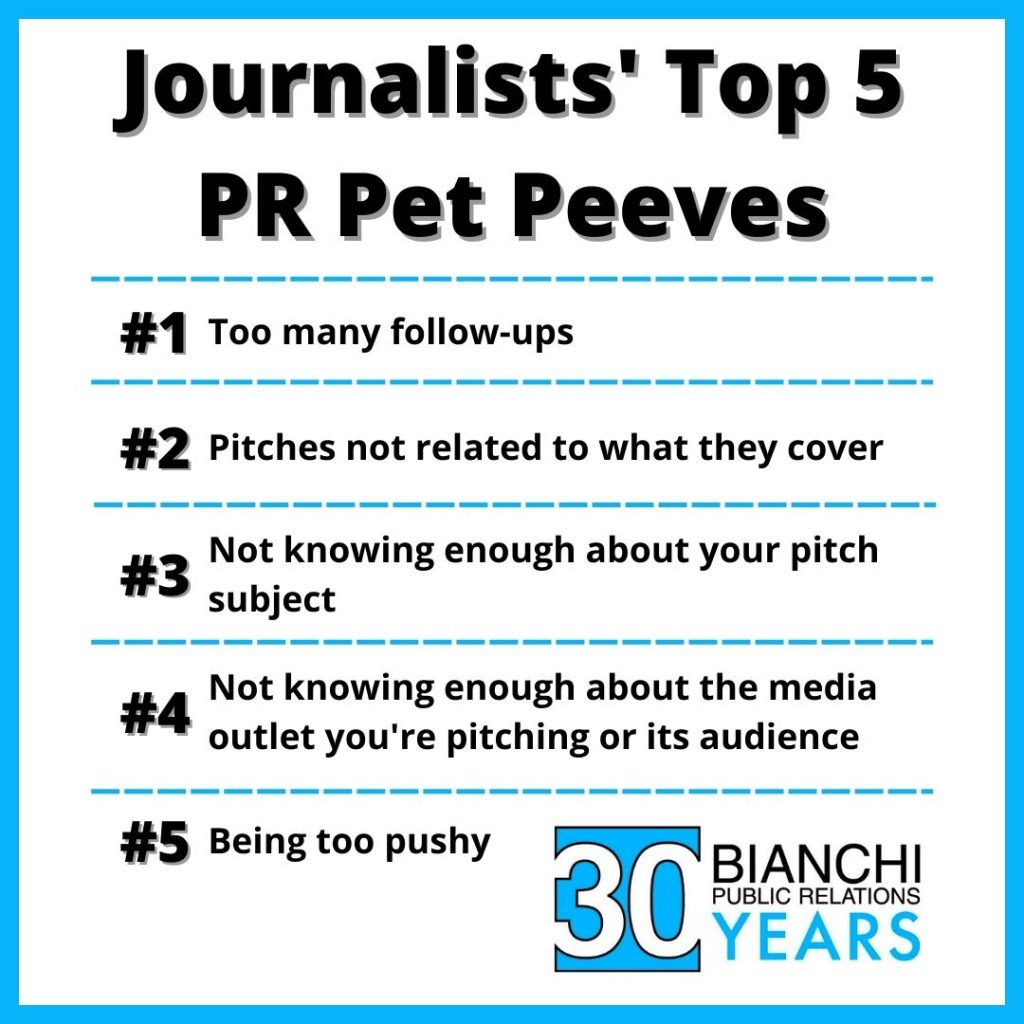901 Tower Drive • Suite 420 •
Troy, Michigan 48098
• P: 248.269.1122 •
E: bianchipr@bianchipr.com
901 Tower Drive • Suite 420 •
Troy, Michigan 48098
• P: 248.269.1122 •
E: bianchipr@bianchipr.com

We’ve found many PR professionals are making simple but crucial mistakes that are causing their pitches to be tossed or ignored based on a review of the input Bianchi PR has been collecting from journalists through our “Meet the Media” blog series.
Instead of just pontificating ourselves about how PR professionals can make an impactful pitch, we went directly to the source and gathered journalists’ responses to our query about their PR pet peeves and what advice they had for PR people.
This kind of input is actually part of the reason we created the “Meet the Media” blog series. Now our most popular blog feature, we pose questions to journalists to help PR folks, especially those in the automotive, mobility, commercial vehicle and Detroit business sectors, to better understand how they can better serve journalists.
In this post, we’ve pulled some excerpts from our more than 130 “Meet the Media” profiles to help answer the vital question: what do journalists really want?
So, straight from journalists’ mouths, here are the top five pet peeves and advice:
1. Too many follow-ups
Consider this comment from Sara Jensen of Power & Motion: “Too many sequential follow-up calls or emails…everyone is busy, give us a little time to review and think on your pitch.”
Pro Advice: Be aware of the number of emails and phone calls journalists get every day. Give them time to review your email and respond. Note: if they think your pitch is a good fit for them, they’ll respond, so don’t flood their inbox.
Consider the advice from Robert Schoenberger of IndustryWeek: “Just understand the volume of material we get.”
2. Pitches not related to what they cover
Consider this response from the freelance automotive journalist Nicole Wakelin: “I cover automotive, yet I get an astounding number of pitches for baby products. I’m a mom but that’s not what I write about, and it irks me something fierce when people send me mom stuff just because I’m a woman.”
Or this comment from Audrey LaForest of Automotive News: “I’m not sure how I end up on PR email lists that have nothing to do with my beat coverage. If there’s a way to clean up your lists periodically, please do!”
Pro Advice: Do your research to better understand what not only each journalist covers but also what would be an appropriate topic for their outlet.
Here is a bit of advice from Jim Park of Heavy Duty Trucking & TruckNews: “Understand the market I write for. I cover the heavy-duty trucking industry. I get lots of pitches for stories on the automotive industry, which occasionally cross over, but it’s rare. Sometimes it’s healthcare or municipal politics … I honestly don’t know how I manage to get on some email distribution lists. There’s plenty of relevant material vying for my attention, so I’m likely not to respond to pitches that are not related to the industry I cover.”
3. Not knowing enough about the company
Consider this response from Rebecca Lindland, a former automotive industry analyst & freelance writer: “Please, know your history. Read about the brand you’re serving or the technology you’re pitching. Know the backstory, and the people involved.”
Pro Advice: Have a better understanding of the content of the pitch, and really understand the outlet you’re pitching to. It is important to be knowledgeable about the journalist, but also be aware of the company or brand you’re working for.
4. Not knowing enough about the media outlet (and its audience) you’re pitching to
Pro Advice: Understand that you need to educate yourself not only on the publication and journalist but also their audience – what’s interesting, important and helpful to them?
Consider this piece of advice from Kurt Nagl of Crain’s Detroit Business: “Knowing a bit about our publication and target audience is helpful.”
Or this piece of advice from Philip Nussel of Automotive News: “Please, I’m begging you, don’t waste your time or mine pitching a story that’s irrelevant to my audience. If you don’t know the audience served by the target of your pitch, you will not get to first base with me or anyone else. E-mail is best. Do not call unless it is absolutely urgent to bring my attention to a scoop or breaking news. Also, please don’t lie to me or my editors about what other news organizations are working on the same story. If you are offering me the story first, I might be willing to listen more. I do not want to invest resources in a story you’ve already given to my competitor(s). If we are a “second tier” pitch, you are insulting me. Embargoes are fine as long as nobody else gets an earlier embargo.”
5. Being too pushy
Consider this response from freelance automotive journalist Gary Witzenburg: “Don’t be pushy. I have worked on and understand the PR side of our business. Attendance at your press function does not guarantee a story, let alone a positive one. Your (and your company’s) job is to make your product or message so interesting and compelling (to our audiences) that it earns good stories.”
Or this response from Vesna Brajkovic of Heavy Duty Trucking & TruckingInfo.com: “Just pushing this to the top of your inbox…” / “In case you missed it…” emails. I do get A LOT of emails, but I think it’s a misconception that that must mean I don’t read them. I do. Too many follow-ups create unnecessary inbox clutter. I also don’t like phone calls that are in the same vein. They interrupt my workflow – my worst nightmare.”
Pro Advice: Don’t try to “sell” a journalist too hard. They are people, not objects.
If you keep these five pet peeves in mind as you start developing your next media pitch, you’re likely to be more successful as a PR professional … and hopefully, a trusted media resource.

Author: Alexandra (Allie) Laird
Allie is an intern at Bianchi PR for the summer 2022 semester. You can connect with Allie on LinkedIn here.
You might also be interested in:
One Trackback